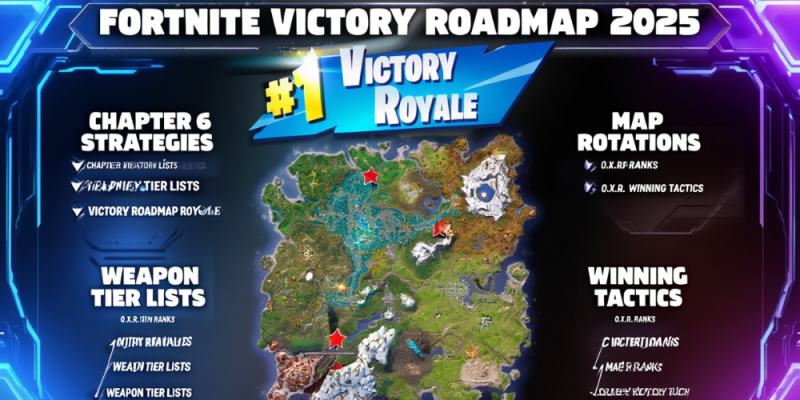Fortnite Victory Roadmap: The Complete Big Guide for 2025
2025-11-11

Fortnite looks friendly, but winning needs structure, not luck. This big guide gives you a clear path from first drop to last circle in both Build and Zero Build. You will learn how to set up your game for smooth frames, how to pick safe but useful landing spots, and how to build a loadout that fits the current season. We keep the language simple and the advice practical, so you can try each idea in your next match.
The game meta changes, yet core habits stay strong: keep your aim steady, play smart positions, carry mobility, and rotate early. Think of this as a toolbox you can open any time. Start with setup, then focus on landing and early fights, and finally master rotations, endgame, and team play. If you improve one small habit each session, your results will grow fast.
Main Guide
Choose Your Mode and Mindset
Pick one main mode for the week. Build teaches you piece placement, edits, and height control. Zero Build sharpens awareness, map reading, and cover usage. Both share the same gunplay rules and storm pressure, but they reward different instincts. In Build, you can save bad pushes with walls and cones; in Zero Build, you avoid bad pushes by reading terrain and timing. Decide your focus, set simple goals like “win off‑angles” or “rotate before the crowd,” and judge success by decisions, not only by eliminations.
Settings That Matter
Stable frames beat pretty shadows. Lower effects and shadows first, then cap FPS slightly under your average to avoid stutter. Turn on Visualize Sound Effects if audio is hard to track, but reduce HUD size so it does not block your view. On mouse, a low to medium sensitivity helps you track without over‑shooting. On controller, tune deadzones so sticks do not drift and pick Linear if you like snappy aim or Exponential for smoother curves. Use Preferred Item Slots so your shotgun, AR, heals, and utility always land where your fingers expect them.
Landing Strategy and Early Fights
Plan two landing routes: one hot point of interest for fast practice and one quieter landmark for stable games. Glide to a roof or chest that gives a first gun, then shields, then more heals. If someone lands on your building, meet them early—timing beats panic. If you are outnumbered, break line of sight and reset with an exit like a zipline or river path. The goal is to leave the area healthy, with at least one close‑range weapon, one mid‑range option, and a movement tool. Do not mine loudly or loot with your back to doors; keep the camera moving and listen for steps.
Loadouts and Inventory Logic
Carry a simple, repeatable kit: close‑range (shotgun or strong SMG), mid‑range (AR or marksman), shields, heals, and one utility or mobility slot. Swap in a long‑range piece only if the season supports it and you have ammo to feed it. Upgrade rarity when it is cheap and safe; a blue gun in position beats a gold gun in the open. After each fight, reload everything, rebalance your inventory so key items sit in the same slots, and top off shields before looting the rest. If ammo is low, choose weapons that burn less per fight.
Movement and Positioning
Good movement makes you hard to hit and buys time to heal. Use sprint, slide, and mantle to change height and break aim assist or tracking. Move along cover lines—ledges, rocks, trees, and walls—so only part of your body is visible. Avoid running flat across fields; angle toward ridges and make short dashes from one piece of cover to the next. High ground is strong, but only if you have exits; a tall tower without mobility is a trap. When third parties show up, stop tunneling, heal, and shift to a fresh angle before you shoot again.
Combat Fundamentals
Keep your crosshair at head or chest level as you traverse; this turns reactions into instant hits. Start fights on your terms: tag first from cover, then push after you crack shields. Up close, a clean shotgun shot followed by a fast swap to SMG or AR is more reliable than spamming the same weapon. At mid‑range, burst or tap to control bloom and counter‑strafe to keep your spread tight. When your shields break, do not ego peek. Reset the fight with cover, builds, or mobility, then re‑engage when you have health, ammo, and a better angle.
Build Essentials
In Build, defense first. Learn to make a fast box—four walls, a floor, and a cone—and to add a second layer if sprays keep coming. Practice right‑hand peeks with a small corner window so you see more of your target than they see of you. Piece control wins trades: dropping a cone into an enemy box blocks edits and slows their options. Climb with simple, safe patterns like ramp plus wall, adding a floor to protect from shots below. Keep builds tidy; place only what protects you or creates a clean line of fire. Save mats for midgame and endgame where they buy more value.
Zero Build Playbook
Without pieces, terrain is your shield. Before you shoot, ask “where do I go if I take damage?” Hold rooftops, cliffs, and tall dunes that give sight lines and easy escapes. Open with beam damage and push only when you have a clear health lead or flank. Mobility is your lifeline; carry at least one escape or engage tool. Vehicles help, but noise draws eyes, so change routes and abandon cars before tight circles. If a team holds a head‑glitch, use utility to move them: grenades to flush, smokes or deployable cover to cross, and elevation to deny their angle.
Rotations and Zone Control
Think two circles ahead. If the next safe zone favors high ground, move early and claim a strong ridge. If it pulls across water or open fields, plot a path that chains cover and remembers backup spots. Rotating late with the crowd is loud and risky; rotating too early without plan can trap you. The sweet spot is an early move to a power position with good exits. From there, watch edges for players forced by the storm, tag safely to create pressure, and refuse chases that drag you into bad ground. In moving circles, make short, controlled moves and reset after each step.
Duos and Squads Communication
Teams win by trading and timing, not hero plays. Keep callouts short and clear: mark threats, name skins, and use the compass. Decide simple roles before the drop—one entry to start fights, one anchor to hold positions, one support to track heals and utility. Double‑swing angles so you trade if one player goes down. After every fight, say what you need and redistribute shields, ammo, and mobility before looting deeper. If a revive is risky, stabilize first, set cover, then commit. Keep the group within quick help range; distance creates 2v1s you never wanted.
Ranked Focus and Practice Plan
In ranked, your points come from placement plus safe eliminations. Play edges if you want fewer fights and more control, or hold strong center positions if your aim and resources are high. Review one or two replays after a session and ask, “What choice ended this run?” Fix that first—late rotate, poor peek, no exit—before chasing aim gains. For practice, spend a few minutes daily on tracking and micro‑adjustments, then run short drills: wall edits and ramp flips in Build, or cover slides and peeks in Zero Build. End with three real matches focused on one goal like “rotate early” or “win first shot.”
Performance Tips for PC and Console
Update GPU drivers and clear shader caches before big patches. Close heavy background apps and set a frame cap that matches your monitor’s refresh minus a small buffer. Use a sharp resolution scale you can actually drive; a clean, stable image beats a blurry, unstable one. On console, pick Performance mode, enable a low‑latency setting on your display, and sit close enough to read silhouettes. Keep audio at a level where you can hear steps, reboots, and reloads without strain. Simple tech stability makes decision‑making easier in the final circles.
Conclusion
Winning Fortnite is a chain of small, repeatable moves: stable frames, a planned drop, a balanced loadout, clean angles, and early, smart rotations. Choose one mode to focus on, carry mobility every game, and reset fights when they turn messy. Speak clearly in teams, share resources, and review one mistake after each session. Keep your habits simple, your plan flexible, and your nerves calm in the last zones, and you will see more late games turn into Victory Royales.
- Land on a weapon, then shields, then heals; leave early if outnumbered.
- Hold right‑hand peeks in Build; play ridges and rooftops in Zero Build.
- Rotate two circles ahead and pick positions with exits, not just views.
- After every fight, reload, heal, and reset your inventory order.
- Practice a little daily and fix one clear mistake per session.





